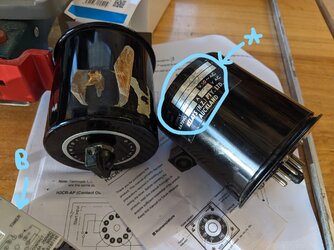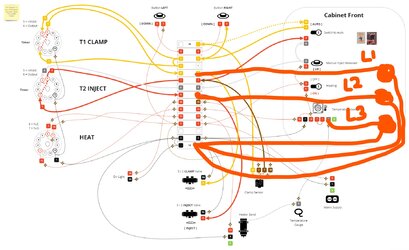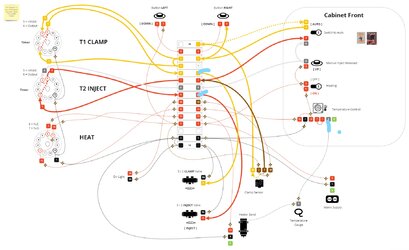M
murd_the_nerd
Hi there
Complete novice electrical wise. I am refurbishing an old 1950s Injection Moulding machine and looking to replace the Power Timer Relays. So far with no success myself and two attempts. It appears I need some expert help. I would love direction on the type of timer I need and a link to where I could purchase is a bonus. Any help much appreciated. Details below:
The old Timers:

What I've investigated:
Diagrams that I've mapped to help explain how the Timers work and current wiring:


If you need any more info I'm happy to provide. And even if you are just interested in the machine I can post pictures of that also
Thanks
Murdoch
Complete novice electrical wise. I am refurbishing an old 1950s Injection Moulding machine and looking to replace the Power Timer Relays. So far with no success myself and two attempts. It appears I need some expert help. I would love direction on the type of timer I need and a link to where I could purchase is a bonus. Any help much appreciated. Details below:
The old Timers:
What I've investigated:
- There are 2x Timers, one for inject and one for clamp
- They are both the same, because I can swap them around and it still runs just fine
- Markings still remaining on one says Supply 230 V AC and Rating 6A 230 V AC. There is no cut down in power on this machine, 240V throughout.
- They appear to be short-circuit driven (not power on all the time and Start commands etc)
- Power is only supplied when they run and is instantly straight through to the output
- 11 pin circular configuration
- Phase to pin 2, Neutral to pin 10
- Power into pin 5 and 2 makes the output run forever until short-circuited. I think I've heard this called an Inhibit function which allows the Timer to pause and force power through pin 6. In the clamp instance this forces the clamp closed, lets the inject sequence run, and then allows the Timer to run before cutting power and releasing the clamp.
- Pin 6 is the only output. This runs to the 5/2 solenoid valves and changes the valve position for either inject or clamp
- Timer appears to be a Power Off Delay or similar as it only tells it when to cut power off
Diagrams that I've mapped to help explain how the Timers work and current wiring:
If you need any more info I'm happy to provide. And even if you are just interested in the machine I can post pictures of that also

Thanks
Murdoch



 la-302376642891&gclid=CjwKCAiAgvKQBhBbEiwAaPQw3PKQPeh7zExzTVve1WMoT2jRpbFI38x3yiulbOparbQKTL-P_mZxfxoC1tgQAvD_BwE&gclsrc=aw.ds
la-302376642891&gclid=CjwKCAiAgvKQBhBbEiwAaPQw3PKQPeh7zExzTVve1WMoT2jRpbFI38x3yiulbOparbQKTL-P_mZxfxoC1tgQAvD_BwE&gclsrc=aw.ds







